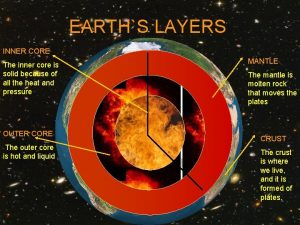Composition of the Earths inner core from high




- Slides: 4

Composition of the Earth’s inner core from high pressure sound velocity measurements of Fe-Ni-Si alloys S. Dominijanni 1, C. Mc. Cammon 1, E. Ohtani 2, D. Ikuta 2, T. Sakamaki 2, T. Ishii 1 Bayerisches Geoinstitut, University of Bayreuth, Germany Department of Earth and Planetary Material Science, Graduate School of Science, Tohoku University, Sendai Miyagi, Japan. 1 2 Scientific background § We therefore investigated the sound velocities and density of B 2 -Fe 0. 78 Ni 0. 07 Si 0. 15 alloy to clarify the role of Si as light element in the Earth inner core. iron re ’s co Earth ICB Pure center of the Earth § Knowledge of the high-pressure and hightemperature behaviour and properties of Fe-Ni alloys that contain light elements, such as silicon, is still limited; Density deficit (O, Si, S, C, H) Density (g/cm 3) § Earth’s inner core likely consist of hcp-Fe-Ni alloys + ~10 % of “light elements” to match the density and sound wave velocities of seismological models, like the Preliminary Reference Earth Model (PREM, Fig. 1); Pressure (GPa) Fig. 1. Density profile of hcp-Fe (Dewaele et al. , 2006) compared with the PREM (Dzievonski and Anderson, 1981). Serena. Dominijanni@uni-bayreuth. de

Experimental methods 1) Synthesis of the sample § Multi anvil apparatus – Pressure 8(1) GPa, Temperature 1200(50) °C § Starting material: Fe (0. 78 wt. %), Ni (0. 07 wt. %), Si (0. 15 wt. %) 2) Analyses of the run products § SEM analysis were performed to verify the homogeneity of the sample (Fig. 2) 3) 20 µm Fig. 2. Backscattered electron image of the synthesized sample. High pressure experiments in diamond anvil cell (DAC) § Inelastic X-ray scattering (IXS): SPring-8 synchrotron facility (BL 35 XU beamline, JP) § Powder X-ray diffraction (XRD): DESY synchrotron facility (P 02. 02, PETRA III, DE) 4) Data processing § IXS spectra were fitted using Lorentzian functions § XRD patterns have been refined with the Le. Bail method Fig. 3. Schematic diagram of a BX 90 type diamond anvil cell.

Discussions and conclusions § The relation of the sound wave velocities VP (m/s), Vs (m/s) and density ρ (kg/m 3) follows Birch’s law (i. e. there is a linear relationship between density and sound velocities): Comparison with pure Fe Comparison with Fe-Si alloys a Comparison with Fe-Ni-Si alloys b Fig. 4. Birch’s law of B 2 -Fe 0. 78 Ni 0. 07 Si 0. 15 alloy compared with previous studies of pure Fe (a) Fe-Si (b) and Fe-Ni-Si alloys (c). c

Discussions and conclusions § Our results compared with previous studies suggest that the presence of Si in the alloy reduces both density and sound velocities (Vp and Vs) of iron in the Earth’s inner core. This can be clearly observed in Fig. 5, in which our Birch’s law extrapolated at inner core boundary (ICB) conditions provides a closer match to PREM than pure iron. § Based on the results of this study we suggest that a combination of bcc-Fe 0. 78 Ni 0. 07 Si 0. 15 alloy and hcp. Fe is a viable candidate to match with the geophysical observations of Earth’s inner core. Fig. 5. Comparison of the proposed density dependence of the aggregate compressional (Vp) and shear (Vs) sound velocities with the PREM (Dzievonski and Anderson, 1981).






